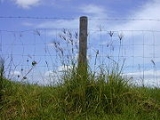
Chloris gayana
Encyclopedia
Chloris gayana is a species of grass
known by the common name Rhodes grass. It is native to Africa but it can be found throughout the tropical and subtropical world as a naturalized species
.
It can grow in many types of habitat. It is also cultivated in some areas as a palatable graze
for animals and a groundcover to reduce erosion
and quickly revegetate denuded soil. It is tolerant of moderately saline and alkaline soils and irrigation.
s. It forms tufts and can spread into wide monotypic stands. The inflorescence
is a single or double whorl of fingerlike racemes up to 15 centimeters long. Each spikelet in the raceme is a few millimeters long and contains one or two fertile florets and up to four sterile florets.
Poaceae
The Poaceae is a large and nearly ubiquitous family of flowering plants. Members of this family are commonly called grasses, although the term "grass" is also applied to plants that are not in the Poaceae lineage, including the rushes and sedges...
known by the common name Rhodes grass. It is native to Africa but it can be found throughout the tropical and subtropical world as a naturalized species
Introduced species
An introduced species — or neozoon, alien, exotic, non-indigenous, or non-native species, or simply an introduction, is a species living outside its indigenous or native distributional range, and has arrived in an ecosystem or plant community by human activity, either deliberate or accidental...
.
It can grow in many types of habitat. It is also cultivated in some areas as a palatable graze
Grazing
Grazing generally describes a type of feeding, in which a herbivore feeds on plants , and also on other multicellular autotrophs...
for animals and a groundcover to reduce erosion
Erosion
Erosion is when materials are removed from the surface and changed into something else. It only works by hydraulic actions and transport of solids in the natural environment, and leads to the deposition of these materials elsewhere...
and quickly revegetate denuded soil. It is tolerant of moderately saline and alkaline soils and irrigation.
Description
This is a perennial grass which can reach one half to nearly three meters in height and spreads via stolonStolon
In biology, stolons are horizontal connections between organisms. They may be part of the organism, or of its skeleton; typically, animal stolons are external skeletons.-In botany:...
s. It forms tufts and can spread into wide monotypic stands. The inflorescence
Inflorescence
An inflorescence is a group or cluster of flowers arranged on a stem that is composed of a main branch or a complicated arrangement of branches. Strictly, it is the part of the shoot of seed plants where flowers are formed and which is accordingly modified...
is a single or double whorl of fingerlike racemes up to 15 centimeters long. Each spikelet in the raceme is a few millimeters long and contains one or two fertile florets and up to four sterile florets.

